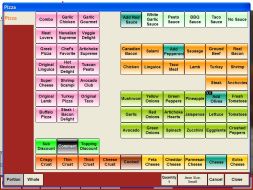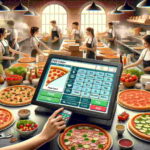The Top Four Challenges of Pizza Point-of-Sale Software

Running a pizzeria have all the challenges of running any other restaurant with demanding customers and long hours. But when it comes to POS technology, your pizza restaurant has unique needs that cannot be met by the software in use at the burger joint down the street. If you are looking for the best pizza POS system for your pizza restaurant, it makes sense to turn to an expert in pizza Point-of-Sale. When evaluating systems, check out these key areas of pizza specific functionality to make sure your choice measures up!
Fractional orders
Everyone’s first question in evaluating a POS system for their pizza restaurant is, “How do one order a ½ and ½ pizza?” It should be quick and easy to place the order, modify either half and add elements to the whole pizza. But beyond the ordering process, a truly pizza-specific POS system should give you flexibility. Do you offer just ½ & ½ or also 1/3 and ¼ pizzas? Can you easily order ¾ or 2/3? How do you price your fractional pizzas – most expensive half, average price, or some combination of topping count average? Can you exclude sizes so that personal pizzas are not created in fractionals? Once the fractional pizza is ordered, how does it appear on printed tickets or the Kitchen Display? Is it going to be clear to the kitchen staff how the pizza should be made?
Pizza pricing
It’s safe to assume that any POS system could add up the price of your items correctly, right? Isn’t that what POS is all about? In the pizza world, pricing is not as easy as it might seem. Unlike most restaurants, where a chicken sandwich is just a flat price, maybe with the option to add Avocado, pizza restaurants are all about creating your own pizza combinations that make pricing complicated. Be sure to evaluate whether your POS system can handle your unique pricing requirements. Many pizzerias charge different based on the total number of toppings on the pizza, like $1.50 per topping for the first 3, $1 per topping for the rest, or choosing 2 toppings free $2 per additional topping. Sometimes specialty toppings are a different price or extra price on top of this. Sometimes removing toppings may reduce the price, or substitutions may cost more. Be sure that your pizza POS system can handle all the variations on your menu!
Coupons
Take a look at the next Sunday paper you get. How many restaurants are publishing coupons? It’s probably a simple offer like – Buy one and get one free if you see any. But look at the pizza coupons – they are probably the most complicated offers you could imagine. Get a free medium one topping with the purchase of a 3 topping pizza on Tuesday or Thursday night, excluding Stuffed Crust. How do you set up these coupons in the POS system to ensure that all the restrictions are followed, easy to apply, and not to lose any money? A good pizza POS system will have extensive coupon controls that are easy to manage. For example, it lets you control which items must be ordered, with size, crust & topping count restrictions. It controls the maximum value of the offer overall and per item. It controls how many offers can be used per order and how many times an individual offer can be used. It controls by date, day of the week, time of day, order type, customer group, and minimum order total required. It gives multiple ways to track and categorize offers, auto-apply, apply with a button, from a list, or a code.
Inventory Control
Food cost is your biggest expense, and you must manage it efficiently. Here is an area where most general POS systems do not measure up for the typical pizzeria. Creating recipes for your pizza items gets back to that complicated topping count formula again. Most pizza cooks know that a 1 topping Pepperoni gets many more slices of pepperoni than a 5 topping Pepperoni, Sausage, Onions, Mushrooms, and Anchovies. But most POS systems do not. If controlling food pricing is vital for you, ensure your pizza POS system can properly manage inventory deductions based on size, crust type, and topping count. Also, ask about how substitutions are managed from an inventory perspective.





